
You know all those new 27.5+ bikes? They are all just 29ers in waiting. Lael customized her Specialized Fuse with new 29×2.6” Nobby Nic tires for her Baja Divide FKT attempt. Keep your eyes open for more 2.6-2.8” tires for 29” wheels in the next year.
Lael began riding a Specialized Fuse Pro last summer. She got it the day before setting off on the Colorado Trail. She had been riding a road bike all summer, the Specialized Ruby which she rode from Alaska to Oregon and raced in the Trans Am Bike Race, and subsequently used on a number of short tours. With the exception of a month of fatbiking in the spring, she had not been on a mountain bike since riding the Advocate Cycles Hayduke in Baja during the winter of 2015-16 when we researched and rode the Baja Divide.
However, the Fuse was a familiar bike as it is similar to the Hayduke, with some minor differences. Most notably the Fuse features a lighter aluminum frame. Frame geometry falls within the same range in most respects, including the 120mm Reba fork that was stock on both bikes. However, our initial iteration of the Fuse saw some customization, including a 130mm Pike fork and an aggressive Dirt Wizard tire up front. The bike worked well, and while the Pike fork was much appreciated, I think a 120mm fork would have served just as well if not better during much of the climbing that is found on the CT. Undoubtedly, when Lael sent the bike downhill her riding was more confident and inspired than before, best compared to how she rode on the Specialized Era, which is the only full-suspension bike she has ever spent time riding. Lael rode the Fuse in this format for the remainder of the year along the first half of the Colorado Trail and over a series of high passes to Grand Junction; from Las Vegas to Lake Tahoe along the new Reno-Vegas route; from the Tahoe Rim Trail to the Bay Area and south to San Diego; and finally, in Baja for two weeks.
Returning to San Diego, we reconfigured the bike for touring the Baja Divide. There, we installed a Lauf Trail Racer Boost suspension fork— a short travel carbon fiber leaf spring fork. We swapped tires to Schwalbe 27.5×3.0″ Rocket Ron (R) and Schwalbe Nobby Nic (F) on new Roval Traverse Fattie SL carbon wheels which feature a nice 38mm internal width. These wheels strike a nice balance between width and weight for this category. Lael has ridden rim widths ranging from 30mm internal diameter to 45mm internal with 3.0” tires and has a strong opinions about rim width. Basically, she hated riding on narrow rims with big tires. Only a small center contact patch was engaged, sideknobs almost never touch the dirt, and the center of the tire wore rapidly. The i45 WTB Scraper that she rode on the Hayduke was very well suited to riding the Baja Divide. Tire volume is maximized, and tire sidewalls are well supported at low pressure. The 38mm internal width of the Roval wheels may have been her favorite all around rim— no doubt because it was made of carbon— but the width does well to provide a useful profile for both traction and flotation, while providing a slightly rounded profile that rolls nicely on narrow singletrack as well. In short, 38-45mm internal rim widths see to be best for 3.0” tires from our experience.
The 38mm rim width in particular would be perfect with the new range of 27.5×2.8” tires which are now available. For instance, Maxxis is making their famed DHF and DHR II tires in 27.5×2.8”, Specialized has a Butcher and a Slaughter in this size, Schwalbe does both Nobby Nic and Rocket Ron in 2.8”, and if you must have tan sidewalls Onza is making a nice looking 2.85” tire. On full suspension trail bikes, we will continue to see 2.8” and 2.8” tires in place of 3.0”. Most likely, 27.5×3.0” will remain most common on hardtails. But something is missing from this conversation— 29” wheels.
In the past year, riders and the industry have fallen in love with 27.5+ wheels. I enjoy riding that size and know how successful it has been in the bike shop setting, especially for new riders or anyone looking to get off the beaten path, so I consider this to be a positive and informative trend, but 29” wheels have been forgotten in the past year. The last time there was any great excitement about 29” wheels, the leading concepts were 2.0-2.2” XC tires, 2.2-2.5” trail tires, and the 3.0” plus tires. It is my opinion that true 29 plus wheels are too big for most riders, and most rides. I don’t expect 29×3.0″ to grow considerably. Bikes like the Trek Stache and Salsa Woodsmoke do well to make a 29+ bike feel a little less like a boat, and the new Salsa Deadwood SUS brings some extra attention to the wheels size in a full-suspension platform, but 2.6-2.8” tires are the future of 29+, or “large-volume 29” tires” as I like to call them. As such, I was extremely excited to see a 29×2.6” Schwalbe Nobby Nic at Interbike this past fall, and I just learned at NAHBS that Terrene is releasing a 29×2.8” tire this summer. I might have ridden that size in Baja this winter if the tires had been ready in time. They weren’t, and instead I finally put some miles on 27.5+ wheels on my Meriwether.
When Lael decided she wanted to do a fast timed ride on the Baja Divide, I presented a large-volume 29” tire as an option. Although 27.5+ felt more confident over sandy sections and large cobblestone chunk, I recall my 29” wheels feeling faster. The rollover argument that has always accompanied 29” wheels is still valid, I believe. I’ve notice Lael getting hung up on obstacles on 27.5+ wheels, where I think a slightly larger wheel would help. But was I remembering correctly? Are 29” wheels faster, and is rollover really that important? After much deliberation, we decided to rebuild the Fuse with wide 29” rims and 2.6” Nobby Nics.
Our parents visited us in southern Baja after touring the Baja Divide this winter, bringing most of the supplies needed to rebuild the bike. The challenge of organizing parts to be shipped to Alaska and New York was far greater than the actual build process, and in the end we dipped into San Diego for a day to pick up a new suspension fork from Cal Coast Bicycles, who were able to get final build parts for us in a day. They have been super supportive of the Baja Divide since our initial rides last season, and they built Lavanya’s Advocate Cycles Seldom Seen this winter. Working in our friend Cale’s workshop, we finalized Lael’s bike build. Almost everything here is exactly as we would have wanted it. I did have an SP dynamo hub for the build but couldn’t get a 28H carbon rim in time, so I bought a 32H SON hub from The Bicycle Shop in Anchorage and laced it to my well used 29” Light Bicycle rim, which features the same dimension as the Roval Traverse Fattie SL 29 carbon wheel used in the rear. Also, the bivy that Lael brought is a thin silnylon VBL, meant to be used inside a sleeping bag to increase warmth. We couldn’t find the other Mont-Bell bivy in Alaska– or at least the friend we had looking for it couldn’t find it— so we grabbed this one instead. Definitely not the best choice, as nights were cold for Lael in northern Baja.
Aside from the wheel and tire size, the other outstanding features of this bike are the light system with the new Sinewave Cycles dynamo light, the 100mm SID fork with the new Charger damper, and the Cirrus Cycles BodyFloat suspension seatpost. Lael also found her favorite cheap Cannondale saddle in a take-off bin at a bike shop in La Paz. This is the same saddle she toured on for many years and used to ride the Tour Divide twice in one summer, so we know it works.
Follow Lael’s Baja Divide FKT attempt on Trackleaders.com, she is 10 days into her ride and only 200 miles from the finish!
———-
Frame: Specialized Fuse, M4 Alloy
Fork: RockShox SID RLC 27.5+/29, 100mm, 51mm offset
Tires: Schwalbe 29×2.6” Snakeskin, Trailstar, TL Easy
Rear wheel: Roval Traverse SL Fattie 148 (30mm internal carbon rim, DT Swiss ratchet freehub, DT Swiss Revolution spokes, 3x)
Front hub: SON28 110mm 32H dynamo hub
Front rim: Light Bicycle carbon, 30mm internal
Front spokes: DT Competition, black alloy nipples, 3x
Stem: Specialized XC 40mm
Handlebar: Specialized carbon, 3/4” rise, cut to about 700mm
Grips: Ergon GP-2 with short bar ends
Seatpost: Cirrus Cycles BodyFloat, purple spring upper and black spring lower
Saddle: Cannondale take-off
Brakes: Guide RSC
Rotors: 160mm SRAM Centerline
Crank: SRAM S-2200 carbon, 30mm spindle
Chainring: Wolftooth 32T elliptical direct mount Drop Stop ring
Pedals: Shimano XTR Race
Bottom bracket: SRAM PF30
Shifter: SRAM GX1
Rear derailleur: SRAM XO1
Cassette: SRAM 1195
Chain: SRAM X1
Luggage: Revelate Designs custom Ranger framebag, oversize Jerry Can, Mag Tank, Viscacha seatpack, Feed Bag
Lights: Sinewave Cycles dynamo light with USB charging and battery input mode, 2x Black Diamond Icon Poler (helmet/handlebar), NiteRider battery taillight
Battery: Anker 10,000mAh battery for backup power to dynamo light at low speeds and while stopped, also for phone charging if needed
Accessories: King Cage top cap water bottle mount, 2x Specialized Rib Cage, 2x Specialized Purist water bottles, Specialized wireless computer, Garmin eTrex 20, ESI handlebar tape on bare section of bars, Stan’s Race Sealant, alloy tubeless valves
Clothing: Nike Pro 3” compression shorts (size XL for comfort), cotton tank top with custom Mexican embroidery patch, Patagonia merino long sleeve top, Patagonia merino bottoms, Patagonia Barely bra, Smartwool PhD lightweight socks, Patagonia midweight socks, REI down vest, Patagonia M10 shell, knit hat purchased in Tecate
Cycling equipment: Specialized Ambush helmet, S-Works XC shoes, Specialized Grail fingerless gloves
Sleeping: reflective windshield sunshade trimmed to size, Etowah silnylon bivy, purchased cheap sweatpants and plastic trash bag on route
Tools, etc.: Crank Brothers M17 multi-tool, Lezyne HP road pump, 2 oz. Stan’s sealant, Presta-Shrader valve adapter, Genuine Innovations tire plugs and tool, curved needle and thread, tube and patch kit, 11sp chain link, DumontTech Lite chain lube
Other: 6L MSR DromLite bladder, toothbrush and toothpaste, sunglasses, sunscreen, Revelate Designs Peso Pouch, 8000 pesos


















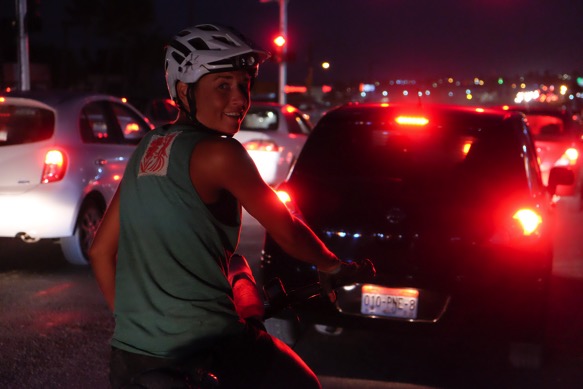














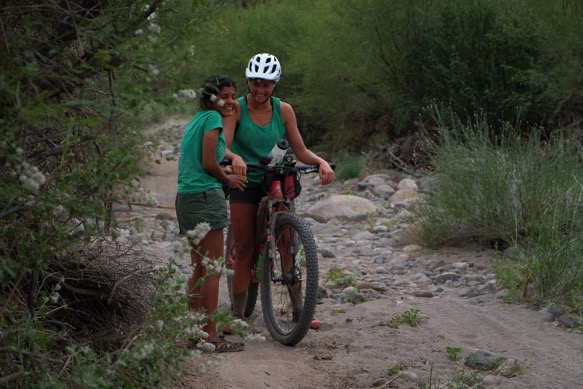




















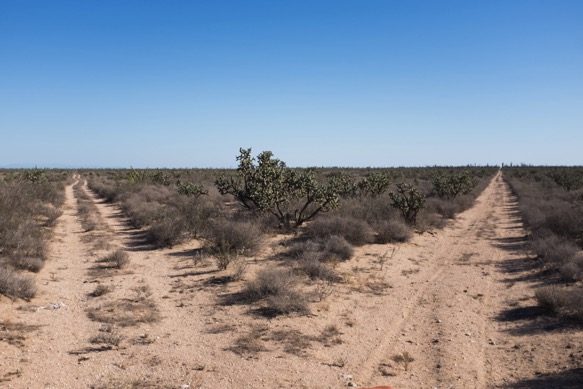

















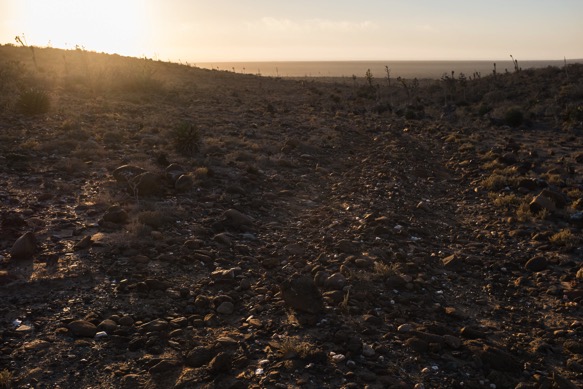



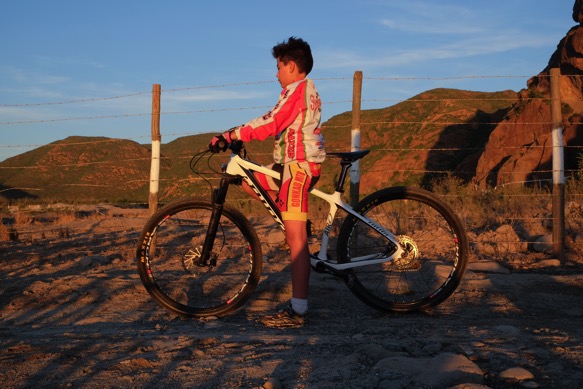










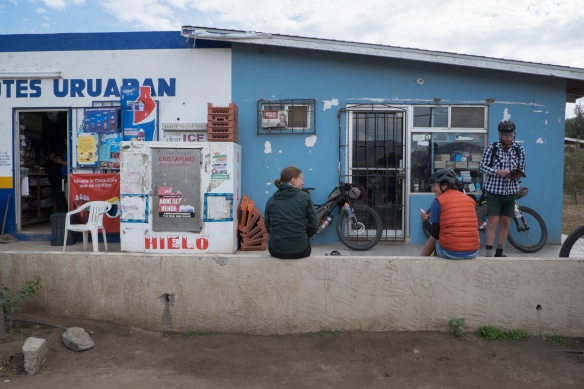
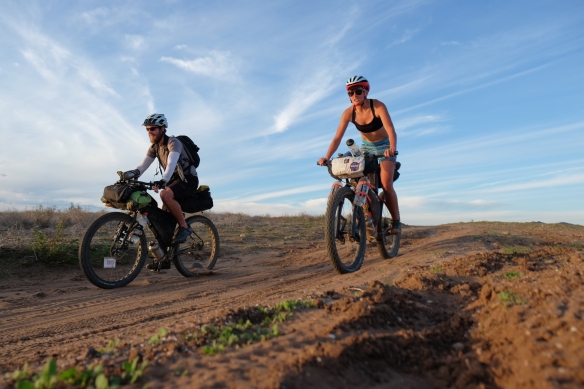
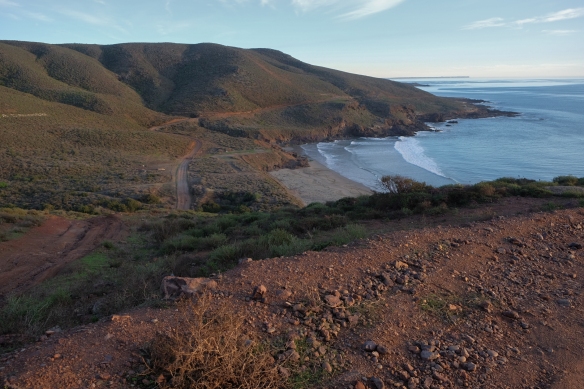

 Jesus and a couple of friend caught up with Lael outside the OXXO this morning as she prepared to ride into the mountains. Jesus was hoping to pedal out of town for a couple of miles. The Baja Divide is also opening new routes to local riders, whose rides typically remain nearer to town. You may need to be signed into Facebook to view this video.
Jesus and a couple of friend caught up with Lael outside the OXXO this morning as she prepared to ride into the mountains. Jesus was hoping to pedal out of town for a couple of miles. The Baja Divide is also opening new routes to local riders, whose rides typically remain nearer to town. You may need to be signed into Facebook to view this video.